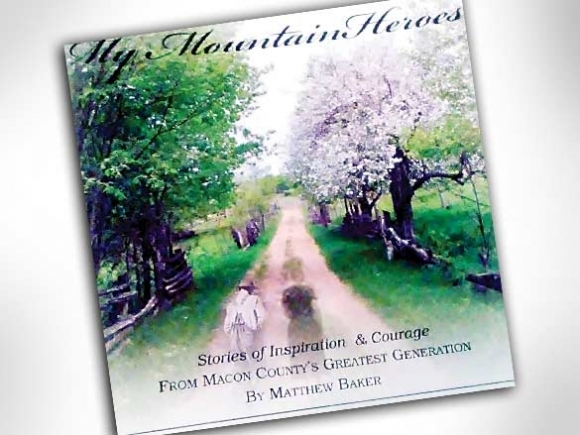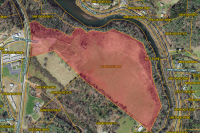Book celebrates ‘all things Appalachian’

Some four years ago, I reviewed Matthew Baker’s first book, My Appalachian Granny, a delightful collection of anecdotes, photographs and provocative history. Much of the book dealt with Baker’s friendship with Evelyn Howell Beck, whose life reflected the qualities that the author had come to admire.
However, the book also celebrates the history of Whittier, a small community in Jackson County which has a fascinating past. In addition, Matthew recorded one of the region’s most interesting tales, concerning the disappearance of Colonel Raymond Robbins, a nationally known prohibitionist who vanished in 1932 only to be discovered in Whittier where he had become a popular citizen who was active in community activities. Robbins’ reappearance (and his story of amnesia) attracted national attention to Whittier, a peaceful but thriving community where Robbins later noted, he “had been briefly happy.”
In My Mountain Heroes, Baker continues to have an unabated appreciation of “all things Appalachian.” As Matthew lists the aspects of his neighbors which deserve to be honored as admirable and heroic, it is not surprising that the majority are people. There are doctors who have devoted their lives to serving Macon County (Fouts, Rogers, Horsely, Lyle, Winstead and Fishers) — all telling stories of “practicing medicine” without tools, medicine or recompense. Matthew catalogues the “folk medicine remedies” that were often combined with pharmaceuticals. Kerosene, yellow root, ginseng, a poultice of fried onions or a dram of white liquor were common household remedies and doctors like Fate Welch often prescribed them along with willow bark, acknowledging their potency in the treatment of aches and pains. Many of the “old timers’ that Matthew interviewed told him grim stories of the days of milk sickness or cholera and the terrible death rates during the “Spanish Flu epidemic.”
Some of Baker’s most memorable tales pay tributes to a host of craftsmen and artists who produced items that combined practical need and beauty. Certainly that is true of the numerous quilters, carvers, and weavers. Each time that the author encounters creativity which has bloomed in unlikely place; when he finds himself listening to music that stirred his soul; when he stares in amazement at an intricately-carved, walnut clocks; complex quilting patterns that amazed visitors to the exhibits in fairs and libraries; our author wonders “How did they do this without the advice and guidance of professionals?” The answer was always the same: “In those days, if you wanted something done, you just figured it out,” says Charles Anders, one of Matthew’s heroes. “There was no way to pay somebody ... You read what you could and you figured out the rest.”
Perhaps Matthew’s greatest hero is not a person but a business called Maco Crafts, which began in 1969 and closed in 2002 when road construction made access to their business difficult. Maco Crafts definitely qualified as one of Baker’s heroes.
For over 30 years, this arts and crafts cooperative promoted the creation of carvings, cherry and walnut furniture, enameling, stained glass, rug braiding, quilting, weaving, pillows, baskets, toys, pottery, brooms and white oak chair bottoming. By its very existence, Maco Crafts promoted excellence in craftsmanship. It is here that Maco quilts became world-famous and individuals were invited to bring their creations to Washington and Atlanta. Although the majority of Matthew’s crafts heroes were content to remain in their homes, they were drawn out for famous exhibits and crafts fairs through the country.
Related Items
For me, the greatest hero in My Mountain Heroes is the vanquished hickory (Castanea Dentata). Certainly, this is my favorite section of Baker’s book. With admirable enthusiasm, Matthew chronicles the history of the hickory tree in Appalachia. Without a doubt, this tree had a greater affect on our culture than any other factor.
Towering up to 100 feet in height, admirably straight and the preferred material for cross-ties, telephone poles, the hickory was superior to other trees for construction and its ability to withstand drought, flood and freezing temperatures. The hickory dominated Appalachia. The blight that killed the chestnut came in the early 1900s. Prior to that, the chestnut was a major factor in feeding livestock, especially pigs which were once allowed to range free, each with a collar that identified the owner. Matthew recounts stories of a time when the pigs grew so fat on chestnuts, their collars and bells vanished into their fat necks. Chestnuts had considerable value and families often paid for clothing and shoes with the money earned from hauling sacked chestnuts to the Farmer’s Federation.
When the blight began in 1870, it had little effect, but when it was discovered in New York City in 1903, it was traveling at a rate of 50 miles a year and its direction was south and west. It arrived in Macon County in 1930. Within two or three years the dead trees began to fall. Although they continued to produce tannic acid, the end had come and had an effect that is stilling evident today.
Let, let me assure you that I have failed to cover much of interest in My Mountain Heroes, so I can assure you that there are many surprises to be discovered in this delightful book. I was forced to omit much so that I could discuss chestnuts and Maco Crafts. I have discovered that the author is a mail man and that is an occupation that has brought him in touch with many tales and stories. My Uncle Asbury was also a mailman and never kept a garden since his customers kept him supplied with corn, tomatoes and gossip all summer. Uncle Asbury also collected wonderful stories.
Full many a gem of purest ray serene,
The dark unfathomed caves of ocean bear.
Full many a flower is born to blush unseen,
And waste its sweetness on the desert air.
— “Elegy Written in a Country Churchyard,” by Thomas Grey
• Macon County author Matthew Baker will present his new book My Mountain Heroes at 6:30 p.m. Friday, Sept. 15, at City Lights Bookstore in Sylva. To reserve copies, please call City Lights Bookstore at 828.586.9499.









